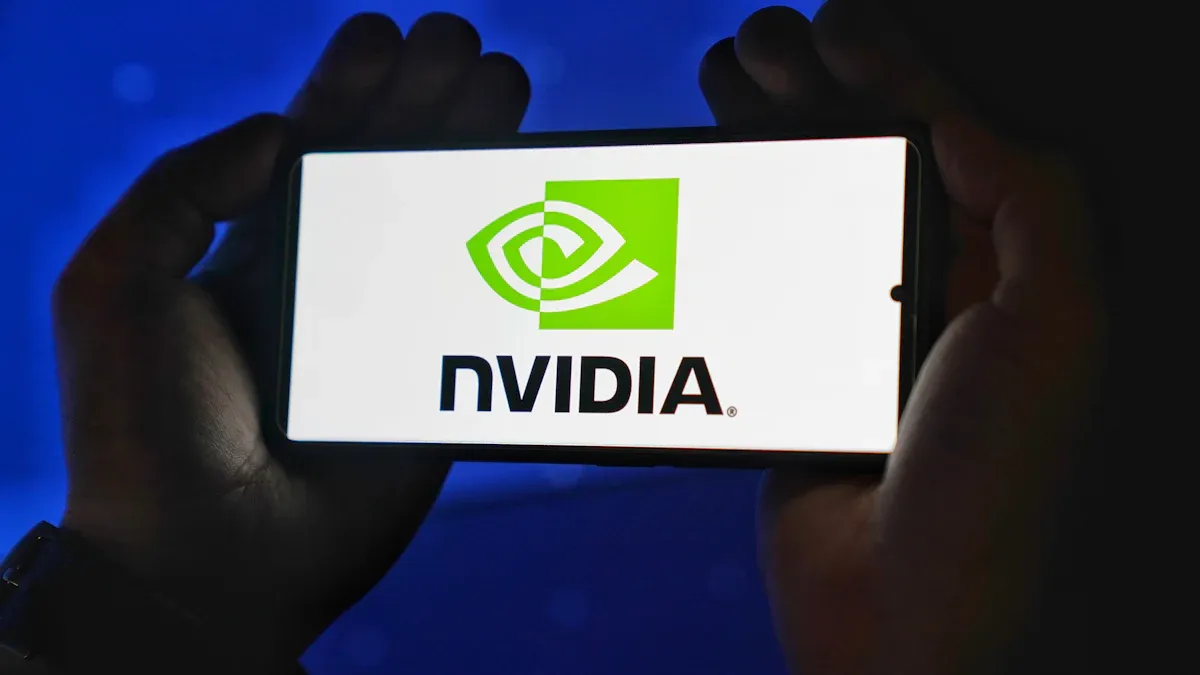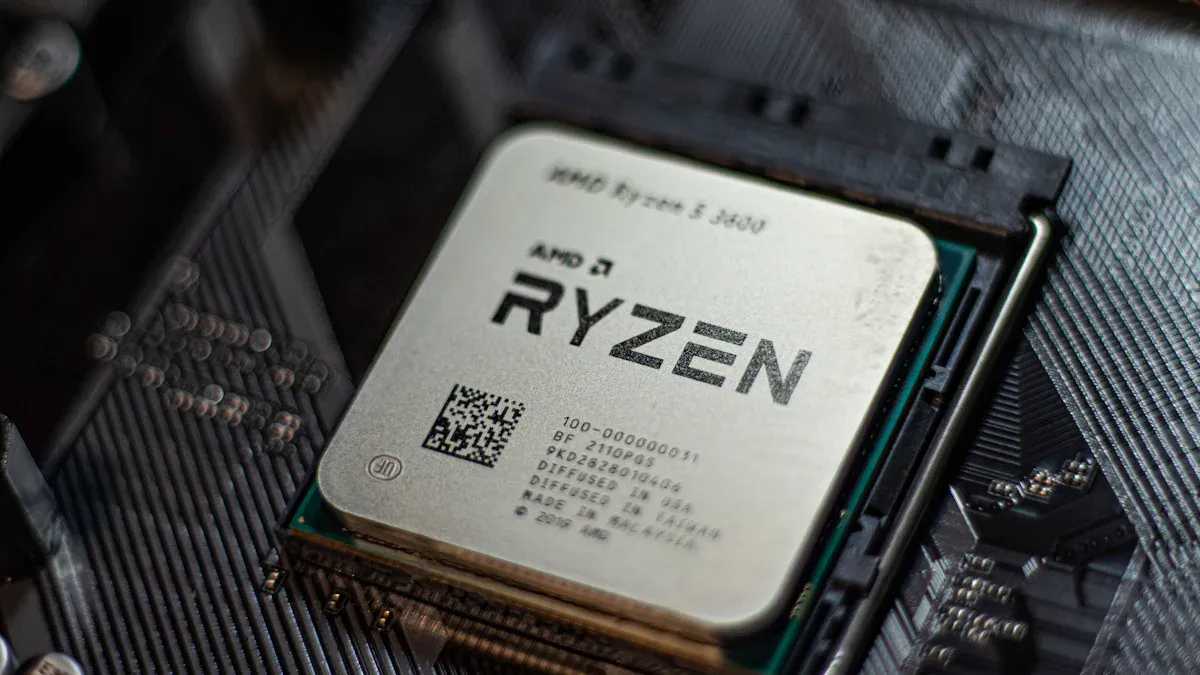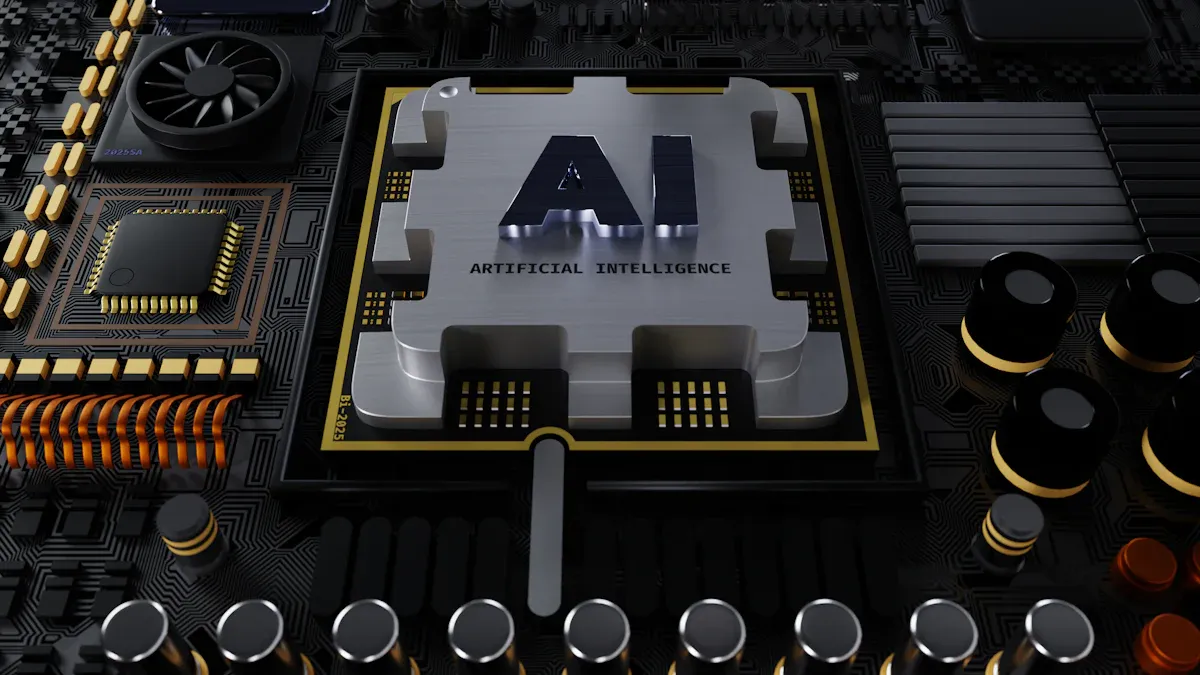AI-Powered Solutions by NVIDIA and AMD Transform the Semiconductor Landscape

AI and the Semiconductor Industry are transforming together, driving significant advancements and growth. Artificial intelligence is not only enhancing the value of the semiconductor sector but also revolutionizing how companies like NVIDIA and AMD innovate and develop cutting-edge technologies.
In the past, semiconductors accounted for 20–30% of a computer's value, but in AI-powered devices, they now represent 40–50%.
Chips specifically designed for AI are experiencing an annual growth rate 18% higher than that of traditional chips.
These developments highlight how AI and the Semiconductor Industry work hand in hand to reduce costs and boost performance. Companies like NVIDIA and AMD are at the forefront, showcasing How to Choose the Right IC for Your Electronics Projects in this rapidly evolving landscape.
Key Takeaways
AI is changing the chip industry, raising chip use in devices from 20-30% to 40-50%.
NVIDIA's Blackwell Ultra design boosts AI speed, making data work faster and saving energy.
AMD's Ryzen AI Max chips add AI tools, helping with tasks like voice commands and picture editing on devices.
Companies like NVIDIA team up with cloud services to improve AI tools, making them easier to use and more helpful.
The AI chip market is growing fast, expected to hit $45 billion in 2024, showing big changes in the industry.
NVIDIA's Role in the AI and Semiconductor Industry

Blackwell Ultra Architecture and Future Roadmap
Key features and performance improvements of Blackwell Ultra
NVIDIA's Blackwell Ultra design is a big step in AI chips. It uses Tensor Core GPUs, which are 12 times better for deep learning. The design also includes the CUDA platform, which boosts AI and machine learning. These updates make data processing faster and save energy. Blackwell Ultra is key to NVIDIA's success in the AI and Semiconductor Industry.
Future roadmap with Rubin and Feynman series
NVIDIA plans to release the Rubin and Feynman series next. Rubin will improve AI tasks in cloud systems. Feynman will focus on edge computing. These plans show NVIDIA's goal to stay ahead in the semiconductor world.
Strategic Cloud Provider Partnerships
Collaborations with Amazon, Microsoft, Google, and Oracle
NVIDIA works with big cloud companies like Amazon, Microsoft, Google, and Oracle. These partnerships make AI easier to use and more effective. For example, NVIDIA helps Microsoft improve Azure's AI tools. Its GPUs also make Bing search faster, cutting wait times by five times.
Adoption of 360 million Blackwell AI chips in 2025
By 2025, 360 million Blackwell AI chips will be used in many industries. This shows how much people want AI-powered solutions. NVIDIA's work with cloud companies keeps its chips important for new AI ideas.
Market Leadership and Financial Growth
2024 revenue of $124.3 billion with 125% YoY growth
NVIDIA's earnings show it leads in the AI and Semiconductor Industry. In 2024, it expects $124.3 billion in revenue, a 125% increase from last year. This growth comes from high demand for its AI chips, which handle 80% of generative AI tasks.
Dominance in AI server markets with H100/H200 products
NVIDIA's H100 and H200 chips lead the AI server market with 86% share. These chips are vital for data centers, managing tough AI tasks efficiently. NVIDIA's focus on better performance keeps it as a top company.
Note: NVIDIA's stock price rose over 200% in 2023. This shows its strong position and how AI has boosted its value.
Metric | NVIDIA Value | Industry Average | Comparison |
|---|---|---|---|
Revenue Growth | 77.94% | 14.97% | Exceptional growth |
AI Data Center Market Share | 86% | N/A | Dominant market position |
Operating Margins (2022-2025) | 66%-63% | 30%-20% | Much higher margins |
AMD's Role in AI and the Semiconductor Industry
AI PC Ecosystem and New Products
Ryzen AI Max and Ryzen 9000HX with built-in NPU AI engines
AMD has made big progress in the AI and Semiconductor Industry. Its Ryzen AI Max and Ryzen 9000HX chips have built-in NPU AI engines. These engines make AI tasks faster and more efficient. They help with voice recognition, image editing, and predictions. By adding AI directly into chips, AMD gives users powerful tools for many tasks.
Working with 16 OEMs to create AI-powered devices
AMD works with 16 Original Equipment Manufacturers (OEMs) to make AI devices. Companies like Lenovo, HP, and Dell use AMD's AI chips in their products. These partnerships improve performance and make computers smarter. This teamwork helps AMD grow in the AI and Semiconductor Industry.
Focus on the Chinese Market
AI centers, 4000 engineers, and the AMD China AI Alliance
AMD has set up AI centers in cities like Beijing and Shanghai. Over 4,000 engineers work there to improve AI for local needs. The AMD China AI Alliance has over 100 members working together on AI projects. This group helps create models like DeepSeek and boosts AMD's role in China.
Support for DeepSeek and teamwork with Qwen
AMD helps develop AI models like DeepSeek and works with Qwen. It also started a global AI competition for developers. AMD supports Chinese universities with tools and training. These efforts speed up AI growth in the region.
AI Trends and Uses
Customization, automation, and smart features in AI PCs
AMD focuses on making AI PCs better for users. AI-as-a-Service (AIaaS) lets businesses use AI without big costs. Edge AI processes data on devices, improving speed and privacy. These changes make AI PCs more useful.
AI tools for gaming, creativity, and productivity
AMD's AI tools make games look better and run faster. Creative workers use them to save time on projects. Productivity apps use AI to handle boring tasks. These tools show how AMD adds AI to everyday computing.
Note: AMD expects $2 billion in AI chip sales in 2024. Its MI300 AI accelerator will play a big role. Data center revenue hit $12.6 billion in 2024, up 94% from last year. This shows AMD's growing power in the AI and Semiconductor Industry.
Comparative Analysis of NVIDIA and AMD
Different Ways of Using AI
NVIDIA's focus on cloud deals and powerful chip designs
NVIDIA leads by making strong chips and teaming with cloud companies. Its AI plan is to be the best and first. NVIDIA offers software and tools that keep customers loyal. This helps it rule the AI training market, especially in data centers. NVIDIA's GPUs and CUDA software work great for medium tasks. This makes them a top pick for AI jobs.
AMD's focus on edge computing and AI in PCs
AMD works on making chips cheaper and faster. Its AI plan focuses on edge computing and smart PCs. AMD puts AI right into its chips for quicker processing. Buying new companies has helped AMD grow in the AI chip market. The MI300X chip beats NVIDIA's H100 SXM in some tasks. This shows AMD can compete in certain areas.
Business Plans and Future Earnings
NVIDIA's lead in AI servers and cloud company teamwork
NVIDIA is strong in AI servers because of cloud company deals. These deals help its GPUs get used in data centers, boosting sales. Experts think NVIDIA will make $58.1 billion in 2024, up 126%. By 2027, its profit margins may reach 64%, showing its smart business moves.
AMD's rise in AI PCs and servers with 14% growth in 2024
AMD aims to grow in AI PCs and servers. It is expected to make $30.5 billion in 2024, a 21.9% increase. This shows AMD's success in offering affordable AI solutions. While NVIDIA leads in AI training, AMD is now second in data center GPUs. Its focus on edge computing and AI PCs helps it grow in the AI world.
Insights from Other Semiconductor Leaders
Infineon's AI Innovations
GaN technology for AI data centers, robotics, and edge computing
Infineon is a major player in improving AI hardware. It uses Gallium Nitride (GaN) chips, which are better than silicon ones. GaN chips work faster and use less energy. This makes them great for AI tasks like robotics and edge computing. They also help save power, which is good for the environment.
AI needs strong hardware, giving companies like Infineon a chance to grow. Infineon is ready to meet the need for special AI chips, especially in cars. This demand will grow the semiconductor market. Infineon plans to use its skills to lead this growth.
Revenue projections of €600 million in 2025, exceeding €1 billion within two years
Infineon expects to earn €600 million in 2025 and over €1 billion soon after. This shows how important hardware is for AI. Chips now make up 40–50% of AI's value, more than in PCs. Infineon's new ideas put it ahead in this big change.
Phison Electronics' aiDAPTIV+ Solution
Cost-effective AI model training and inference for SMEs
Phison Electronics made aiDAPTIV+ to help small businesses use AI. Its DLAP Supreme series makes AI tasks eight times faster. It also trains language models better and costs less. This helps small companies use AI without spending too much money.
Phison uses NAND Flash memory to fix old AI training problems. This lets big models, like Llama 70b, train on normal computers. By making AI cheaper, Phison helps small businesses grow and try new ideas.
Integration of flash memory, SSD, and GPUs for enhanced efficiency
Phison's aiDAPTIV+ combines flash memory, SSDs, and GPUs to improve AI. This mix makes AI faster and cheaper for companies. It also helps businesses grow as their AI needs change. Phison focuses on low cost and high performance, making it a top choice for many industries.
Future Trends in AI-Powered Semiconductor Solutions

How AI Applications Are Changing
Moving from Generative AI to Agentic and Physical AI
AI has changed a lot over time. Early AI, called Classical AI, used simple rules and couldn't adapt much. Then came Statistical Machine Learning, which made decisions using data and probabilities. Now, Generative AI creates things like pictures or text based on prompts. The next step is Agentic AI. This will have systems that think, plan, and act on their own. After that, Physical AI will arrive, where smart systems work in the real world, like robots and self-driving cars.
AI data center demand may hit $1 trillion by 2028
AI data centers are becoming more important. Deloitte says hyperscalers will spend over $220 billion by 2025 to meet energy needs for AI tasks. JLL predicts data center capacity will grow 15% yearly, reaching 20% by 2027. By 2028, the market for AI-powered data centers could be worth $1 trillion. This shows how much AI is shaping the future.
Phase of AI Evolution | Description |
|---|---|
Classical AI | Simple rule-based systems with little flexibility. |
Statistical Machine Learning | Decisions made using data and probabilities. |
Generative AI | Creates new data like images or text based on prompts. |
Agentic AI | Systems that can think, plan, and act alone. |
Teamwork in the AI Ecosystem
Why hardware, software, and system companies must work together
Teamwork is key to making AI better and easier to use. Hardware makers, software creators, and system builders need to join forces. Together, they can make advanced AI tools that work well for many industries. These partnerships also save money and help launch AI solutions faster.
Examples of teamwork making AI better and easier to use
Some partnerships show how teamwork improves AI:
NVIDIA and TSMC use AI tools to make chips more precisely.
AMD and ASRock Rack build better AI servers for data centers.
Microsoft Azure AI and AMD improve AI tasks, showing how Generative AI boosts performance.
NVIDIA and Mercedes-Benz use AI for real-time decisions in self-driving cars.
Collaboration | Description |
|---|---|
NVIDIA and TSMC | AI tools for precise chip-making, showing teamwork in production. |
Microsoft Azure AI and AMD | Faster AI tasks, showing how Generative AI improves performance. |
NVIDIA and Mercedes-Benz | AI for quick decisions in self-driving cars. |
AMD and ASRock Rack | Building better AI servers for modern data centers. |
Note: These examples show how teamwork helps make AI tools better and easier for everyone to use.
NVIDIA and AMD are changing the AI and chip industry. NVIDIA's Hopper design trains AI six times faster. AMD focuses on edge computing to stay ahead. AI tools make chip-making easier and cheaper. The AI chip market could hit $45 billion in 2024. Teamwork between hardware, software, and system makers is key. As AI grows, the chip industry will grow fast too. By 2030, it may earn over $1 trillion.
What does AI do in the semiconductor industry?
AI helps make chips better and faster. It improves chip designs, finds problems early, and speeds up production. AI-powered chips are used in machine learning, gaming, and automation. Companies like NVIDIA and AMD use AI to create new technologies and meet demand.
How are NVIDIA and AMD's AI plans different?
NVIDIA works on cloud computing and strong GPUs for data centers.
AMD focuses on edge computing and adding AI to PCs.
Both aim to lead in AI solutions but focus on different markets.
Why is teamwork important in making AI-powered chips?
Teamwork between hardware, software, and system companies makes AI work smoothly. Partnerships like NVIDIA with TSMC or AMD with ASRock Rack improve speed, lower costs, and bring new ideas. Working together makes AI tools easier to use and grow.
What are the future trends for AI-powered chips?
Moving from Generative AI to smarter and real-world AI.
More need for AI data centers, worth $1 trillion by 2028.
Better edge computing and energy-saving chip designs.
These changes will shape the future of chips.
How are AI chips different from regular chips?
AI chips have special parts like NPUs and Tensor Cores. These parts handle hard tasks like deep learning and language processing. Regular chips can't do this, so AI chips are needed for things like robots, games, and self-driving cars.
See Also
Ensuring Quality Electronics Through Innovative Technology Advancements
Harnessing RV1126 For Advanced AI Robotics Solutions
Enhancing Automotive Efficiency Using NXP Microcontrollers MC9S Series
Unveiling Essential Automotive Features Of FREESCALE MCF5251CVM140
CALL US DIRECTLY
(+86)755-82724686
RM2508,BlockA,JiaheHuaqiangBuilding,ShenNanMiddleRd,Futian District,Shenzhen,518031,CN
www.keepboomingtech.com sales@keepboomingtech.com
